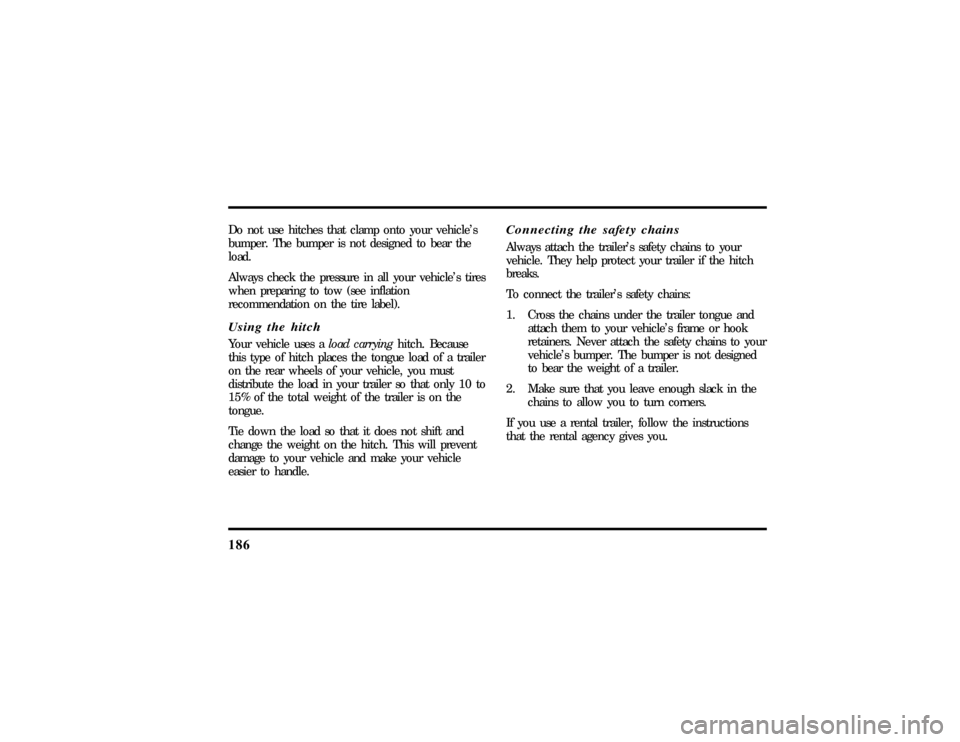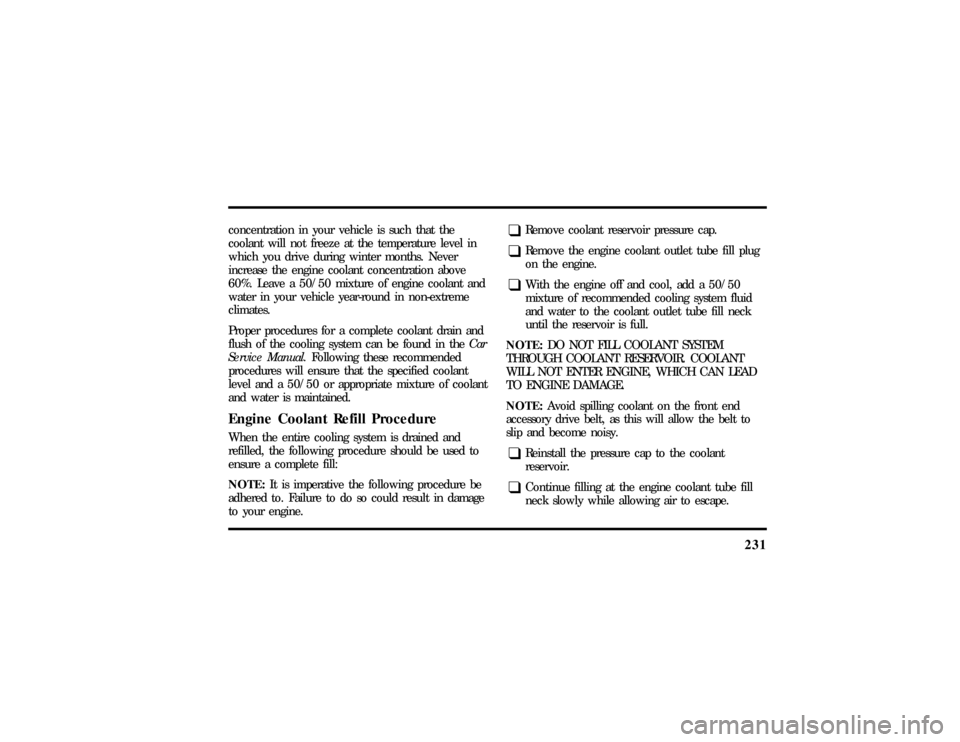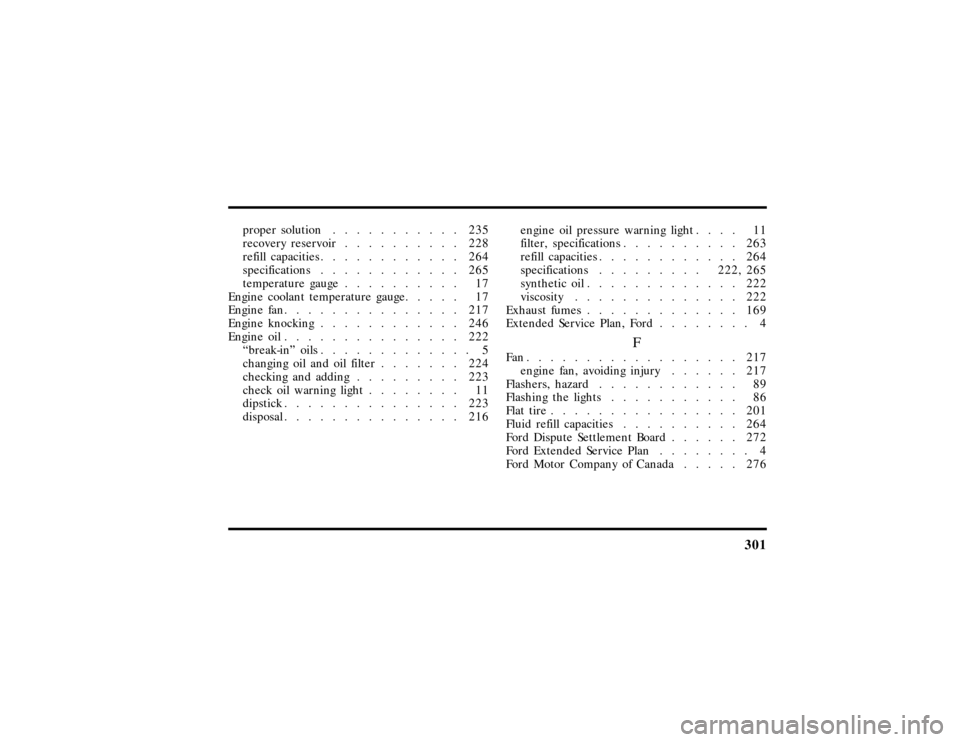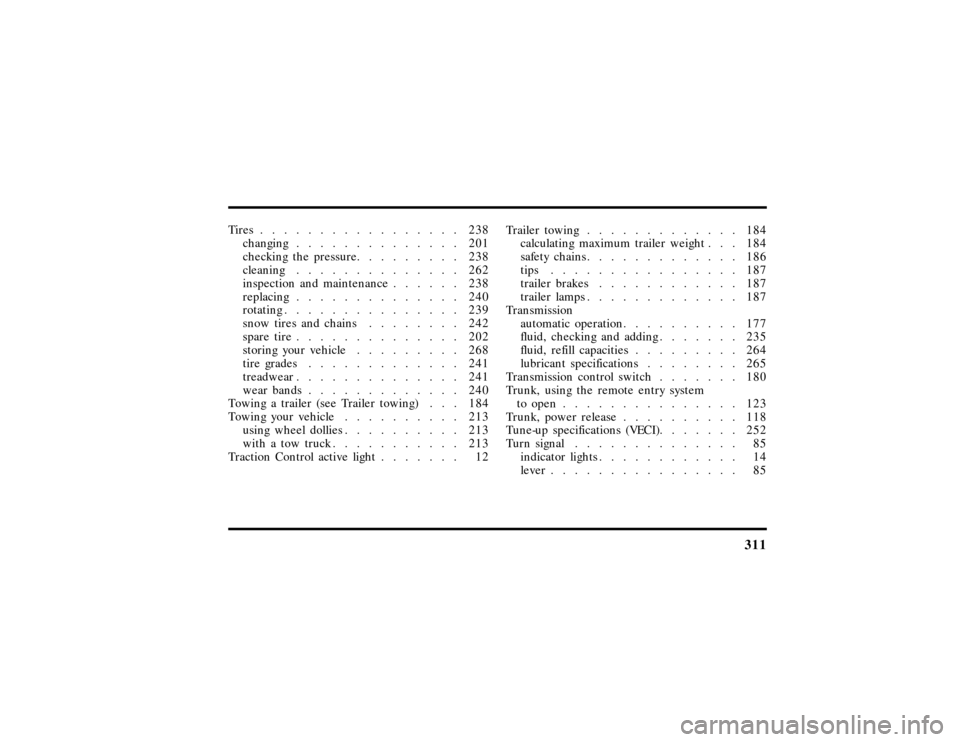Page 191 of 315

186Do not use hitches that clamp onto your vehicle's
bumper. The bumper is not designed to bear the
load.
Always check the pressure in all your vehicle's tires
when preparing to tow (see inflation
recommendation on the tire label).Using the hitchYour vehicle uses aload carryinghitch. Because
this type of hitch places the tongue load of a trailer
on the rear wheels of your vehicle, you must
distribute the load in your trailer so that only 10 to
15% of the total weight of the trailer is on the
tongue.
Tie down the load so that it does not shift and
change the weight on the hitch. This will prevent
damage to your vehicle and make your vehicle
easier to handle.
Connecting the safety chainsAlways attach the trailer's safety chains to your
vehicle. They help protect your trailer if the hitch
breaks.
To connect the trailer's safety chains:
1. Cross the chains under the trailer tongue and
attach them to your vehicle's frame or hook
retainers. Never attach the safety chains to your
vehicle's bumper. The bumper is not designed
to bear the weight of a trailer.
2. Make sure that you leave enough slack in the
chains to allow you to turn corners.
If you use a rental trailer, follow the instructions
that the rental agency gives you.
File:09fngf8.ex
Update:Wed Jun 19 10:45:23 1996
Page 236 of 315

231
concentration in your vehicle is such that the
coolant will not freeze at the temperature level in
which you drive during winter months. Never
increase the engine coolant concentration above
60%. Leave a 50/50 mixture of engine coolant and
water in your vehicle year-round in non-extreme
climates.
Proper procedures for a complete coolant drain and
flush of the cooling system can be found in theCar
Service Manual.Following these recommended
procedures will ensure that the specified coolant
level and a 50/50 or appropriate mixture of coolant
and water is maintained.Engine Coolant Refill ProcedureWhen the entire cooling system is drained and
refilled, the following procedure should be used to
ensure a complete fill:
NOTE:It is imperative the following procedure be
adhered to. Failure to do so could result in damage
to your engine.
q
Remove coolant reservoir pressure cap.
q
Remove the engine coolant outlet tube fill plug
on the engine.
q
With the engine off and cool, add a 50/50
mixture of recommended cooling system fluid
and water to the coolant outlet tube fill neck
until the reservoir is full.
NOTE:DO NOT FILL COOLANT SYSTEM
THROUGH COOLANT RESERVOIR. COOLANT
WILL NOT ENTER ENGINE, WHICH CAN LEAD
TO ENGINE DAMAGE.
NOTE:Avoid spilling coolant on the front end
accessory drive belt, as this will allow the belt to
slip and become noisy.
q
Reinstall the pressure cap to the coolant
reservoir.
q
Continue filling at the engine coolant tube fill
neck slowly while allowing air to escape.
File:11fnmc8.ex
Update:Thu Jun 20 14:28:32 1996
Page 273 of 315
268Batteryq
Check and recharge as necessary.
q
Keep connections clean and covered with a
light coat of grease.
q
If storing your vehicle for more than 30 days
without recharging the battery, disconnect the
battery cables to ensure battery charge is
maintained for quick starting. NOTE: If battery
cables are disconnected, it will be necessary to
reset any memory features (eg. radio presets).
Brakesq
Make sure brakes and parking brake are fully
released.
Tiresq
Maintain recommended air pressures.
Miscellaneousq
Make sure all linkages, cables, levers and clevis
pins under vehicle are covered with grease to
prevent rust.
q
Move vehicles at least 25 feet (8 m) every 15
days to lubricate working parts and prevent
corrosion.
File:12fncs8.ex
Update:Thu Jun 20 14:28:48 1996
Page 302 of 315

301
proper solution........... 235
recovery reservoir.......... 228
refill capacities............ 264
specifications............ 265
temperature gauge.......... 17
Engine coolant temperature gauge..... 17
Engine fan............... 217
Engine knocking............ 246
Engine oil............... 222
ªbreak-inº oils............. 5
changing oil and oil filter....... 224
checking and adding......... 223
check oil warning light........ 11
dipstick............... 223
disposal............... 216engine oil pressure warning light.... 11
filter, specifications.......... 263
refill capacities............ 264
specifications.........222, 265
synthetic oil............. 222
viscosity.............. 222
Exhaust fumes............. 169
Extended Service Plan, Ford........ 4
F
Fan.................. 217
engine fan, avoiding injury...... 217
Flashers, hazard............ 89
Flashing the lights........... 86
Flat tire................ 201
Fluid refill capacities.......... 264
Ford Dispute Settlement Board...... 272
Ford Extended Service Plan........ 4
Ford Motor Company of Canada..... 276
File:fnix8.ex
Update:Thu Jun 27 10:02:38 1996
Page 312 of 315

311
Tires................. 238
changing.............. 201
checking the pressure......... 238
cleaning.............. 262
inspection and maintenance...... 238
replacing.............. 240
rotating............... 239
snow tires and chains........ 242
spare tire.............. 202
storing your vehicle......... 268
tire grades............. 241
treadwear.............. 241
wear bands............. 240
Towing a trailer (see Trailer towing) . . . 184
Towing your vehicle.......... 213
using wheel dollies.......... 213
with a tow truck........... 213
Traction Control active light....... 12Trailer towing............. 184
calculating maximum trailer weight . . . 184
safety chains............. 186
tips................ 187
trailer brakes............ 187
trailer lamps............. 187
Transmission
automatic operation.......... 177
fluid, checking and adding....... 235
fluid, refill capacities......... 264
lubricant specifications........ 265
Transmission control switch....... 180
Trunk, using the remote entry system
to open............... 123
Trunk, power release.......... 118
Tune-up specifications (VECI)....... 252
Turn signal.............. 85
indicator lights............ 14
lever................ 85
File:fnix8.ex
Update:Thu Jun 27 10:02:38 1996